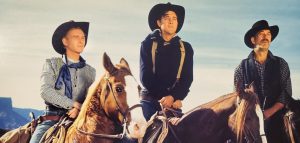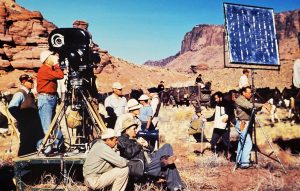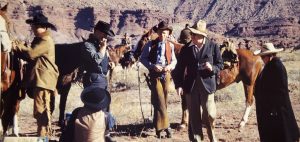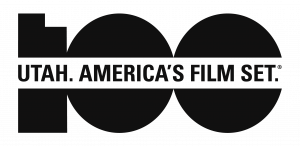Archive Classics Series: WAGON MASTER (1950) — Friday, February 9, 7:00pm – Library Auditorium

The Series
This semester’s presentation for the ARCHIVE CLASSICS FILM SERIES is WAGON MASTER from 1950.
This series features the presentation of cinematic gems held in the BYU MOTION PICTURE ARCHIVE.
These films are esteemed to be of particular importance to BYU Students, focusing on depictions, representations, and expressions of latter-day saints in the medium of the cinema.
The venerable Western director John Ford features a latter-day saint wagon train as a key component of this film, and his exploration of religious refugees heading to establish their own community is one worthy of watching.

Wagon Master and The World’s Longest Running Film Commission
While filming She Wore a Yellow Ribbon in Monument Valley, John Ford traveled north to an area near the town of Moab to scout out new locations. There he met George White, a local rancher who knew the area well. During Ford’s first visit to scout out locations, White took him to various sites and related the history of the area, including the dramatic stories of settlers coming in their wagons to this rugged country. Ford decided that he would like to tell the story of some of these settlers and film it in some of the locations near where the events had actually taken place. This would be the basis for the film Wagon Master.
White, who owned a ranch in scenic Professor Valley, was a respected member of the community, and developed a personal relationship with Ford that would initially be similar to other personal connections with filming locations that Ford had developed, such as with his location connection in Monument Valley, Harry Goulding.
As they surveyed locations, Ford and White discussed what resources the filmmakers would require, as this would be the first film production in the Moab area and the first time White had facilitated a filmmaking process. The filmmakers would need costumes for the background actors who would be brought in from local communities. They needed lodging for the crew and actors who were coming from Los Angeles. They needed horses, historical-looking buildings, and authentic-looking covered wagons. They also needed roads to be cleared so that buses and trucks could transport the cast and crew to remote locations. White recognized that this would require a coordinated effort. He gathered other community leaders in Moab to informally coordinate the necessary resources.
Moab was a small mining town at this point (1949). We are all aware of the barren and beautiful landscape that surrounds it. This first meeting between John Ford and George White would spark the idea in Grand County residents that their ‘neck of the woods’ could be a filming location destination and bring another source of revenue to locals. They realized that a coordinated effort among the residents was essential to support ongoing filming projects.

John Ford on set directing WAGON MASTER
Two weeks before the cast and crew for Wagon Master arrived, the Moab Times-Independent printed an article by the editor asking the residents to do their best to make the production a success:
A new enterprise has been launched in Moab, with the coming of Argosy Productions for the filming of a major western feature in this vicinity. If there is a genuine effort by local people to give one hundred cents in services and chattels for every dollar expended by the picture company, then the success of this first picture will be assured, and the chances will be more than favorable for filming many more pictures in this locale. . . Moab has a great opportunity for launching an important new industry here. Let’s don’t muff the opportunity.
“Argosy Productions Will Film Utah Pioneers Picture at Moab.” (1949, October 6). Moab Times-Independent.
To court consistent Hollywood production would require collaboration by the community. Rather than pit independent contractors against each other throughout the region, the Moab Movie Committee was formed in 1949 to formally bring resources together and unify the community. Working with one entity that could collaborate many of these local resources was much simpler for filmmakers and allowed the community to work collectively. The studios preferred to trust a coordinated committee that would charge fair prices in order to attract future collaborations, rather than work with single contractors who might seek a short-sighted overcharge for goods or services.
With the formation of the committee, the town as a whole observed and embraced learning about the Hollywood system so that local resources could be coordinated for subsequent productions as much as possible. They wanted to accommodate more film productions in the future, and by establishing the committee to unify the town, they were poised to support an industry that would outgrow single individuals.
After the wrapping of Wagon Master, the Movie Committee, recognized the need to proactively promote the area if filmmaking was to become a successful industry in eastern Utah. To do so, the committee sent representatives to Hollywood to sell Moab as a film production location. Promotional materials, sponsored by local businesses, outlined amenities like telephones, local extras, equipment, and builders and featured high-quality photographs of the region’s diverse landscapes. Local businesses also donated services to arrange fundraising drives to cover travel expenses to Hollywood for promotional visits. Media production has become a source of income for the region ever since.
The Moab Movie Committee has changed names over the years, but it is now the longest-running film commission in the world. It all started with the production of Wagon Master in 1950.

John Ford on set directing WAGON MASTER
Utah’s Centennial Cinema Celebration
This year marks the centennial celebration of film and television in Utah (starting in 1924). Year long events are planned to mark this celebration. An exhibit at the state capitol runs the length of the year, highlighting Utah’s celebrated status as America’s Film Set. Featured screenings and events throughout the year are occurring, please checkout this events page to keep up with these happenings.
The Screening
We will be screening our celluloid print of Wagon Master, so come hear the clatter of the projector, and stop by the booth to see the miraculous technology of yesterday.
A favorite lecturer and speaker for many years, faculty member from the Media Arts Department, Dean Duncan, will provide additional insight into the film.
Come join us as we talk about this film’s history, the portrayal of latter-day saints, and enjoy an evening of discussion and entertainment with an engaged audience.
Friday February 9 Library Auditorium 7:00 pm